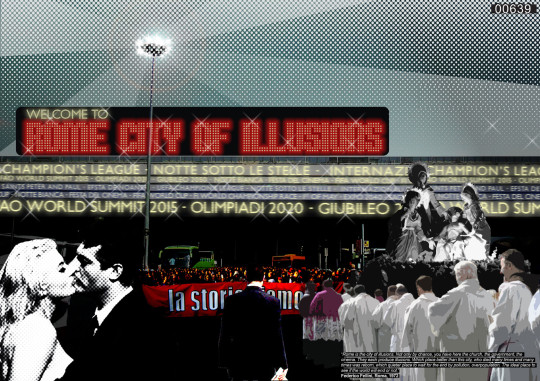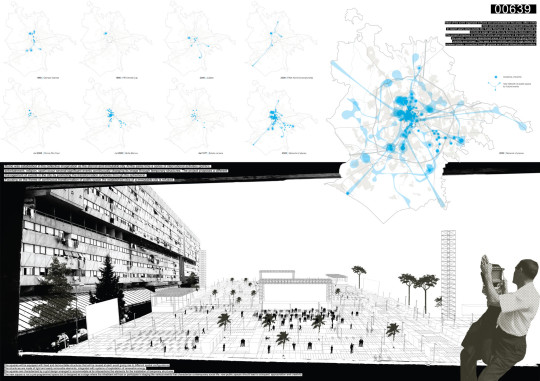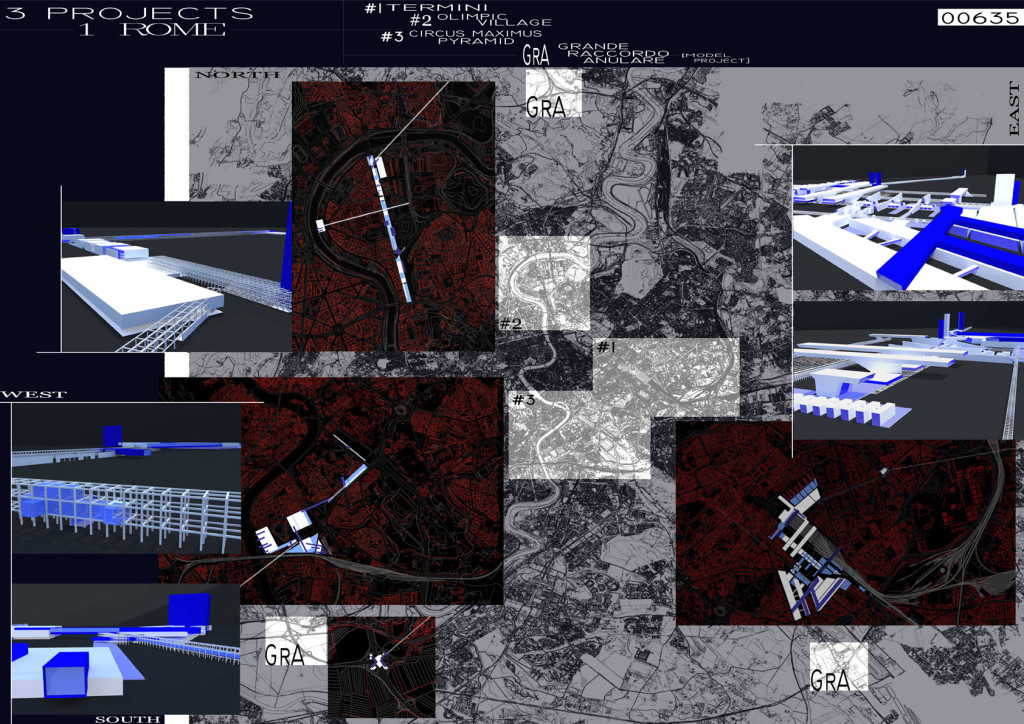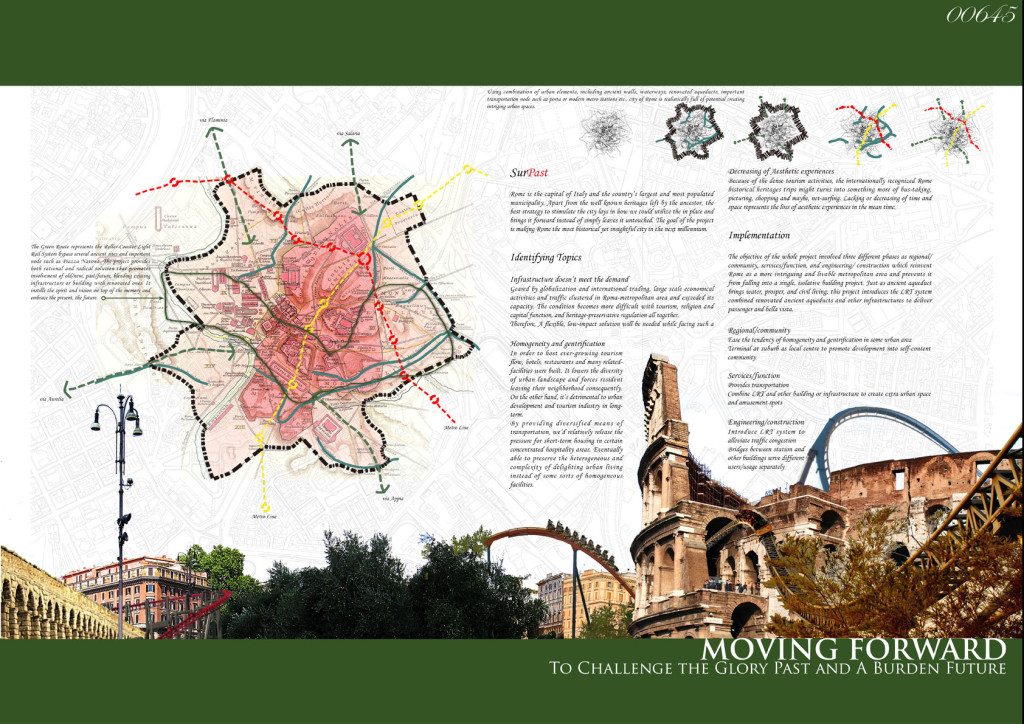Info:
Title: Rome City Of Illusion - Code: 00639Contest: Rome / 2010
By: M. Farina / M. Annese
Views: 4471 Likes: 0
Votes:
JUERGEN MAYER H. 11 FRANCESCO LIPARI6 FELIPE ESCUDERO4 FRANCESCO GATTI 9 MICHAEL CATON 87.6
Rome City Of Illusion


Rome city of illusions
“Rome is the city of illusions. Not only by chance, you have here the church, the government, the cinema. They each produce illusions.
Which place better than this city, who died many times and many times was reborn, which quieter place to wait for the end by pollution, overpopulation. The ideal place to see if the world will end or not.”
Federico Fellini, Roma, 1972
Romewas established in the collective imagination as the eternal city, the result of a secular stratification that has been consolidated in a configuration that seems almost immutable. At the same time in Romea series of international activities (politics, entertainment, religion, sports, etc.) take place occurring a number of significant events continuously changing its image with ephemeral structures.
Currently, the temporary structures needed to manage events (info-point, toilets, sales booths, stages, etc.) are left to self-organization of promoters, often with negative consequences for the city’s image.
The promoters also tend to concentrate these events in the most central and representative part of the city, helping to fuel a stereotyped image of Rometied exclusively to its monumental areas.
One issue is also the management of visitors in a few limited areas, as the events draw crowds fromItaly and all over the world, thanks to the increasing ease of movement and global tourist flows and development facilities accommodation.
The project proposes a different management of events in the city by promoting the transformation of places through the ephemeral. Focusing on the theme of continuous transformation of public space we also want to refuse the established idea of a immutable city that generates controversy for any new intervention. In the history of Rome next to the ‘stone city’ there is a ‘city of the ephemeral’ that we want to renew, with the aim of reaffirming a habit to changing places, not to erase the identity but to renew it every time.
This practice was established in the past especially in the 17th and 18th Century, when huge scenographies were erected during the festivities, continuously transforming the familiar urban environments of the centre. In the 17th Century there was an explosion of the ephemeral popular festivals, with scenographies, hairpieces facades of buildings, fireworks and pyrotechnic equipment, canopies, tanks and holy illuminations that spectacularized holy as secular events. Romewas in those years ‘the Great Theatre of the World’, reflecting the international vocation of its urban setting, already beautiful for its magnificent facades of Baroque palaces. Gian Lorenzo Bernini, the star of this rich period of experimentation on urban spaces, considered the temporary installations an integral part of the renovation project the entire city.
The renewal of the tradition of ephemeral compositions, light shows and entertainment in contemporary started in the Seventies with the summer event ‘Estate Romana’ and was relaunched in recent years with events like the ‘Notte Bianca’, including a larger part of the city beyond the historic centre. The project proposes to involve the whole urban structure in the organization of the events.
A new network of public spaces in the centre as in the suburbs is enabled to receive events through the provision of ephemeral and removable structures, suitable for accommodating all the necessary functions. The new places are connected by dedicated paths where visitors can move by environmentally sustainable transportation (tram lines and bike).
All the urban fabric is then invested by the initiatives related to events, with immediate positive effects in the physical refurbishment of public spaces as in economic development since the introduction of new activities. These sites also acquire a visibility ever known, given the high level media coverage of current events.
The 1960 Olympic games in Rome were the first event covered by live television, with over 100 hours of transmission. Events from that year had a greater media coverage that puts all the places that host them under the eyes of all over the world. The spread in the urban fabric of places suitable for hosting events can revitalize abandoned areas of the suburbs, seeking new centrality within a huge network. The network of places will be both physical and virtual as it will be possible to show by new technologies (pc, screen, web cam, etc.) those appointments taking place in other parts of the city.
The provision of facilities and the visibility of places that goes with it in the new event management will have the immediate effect of attracting the organizers of major world events and the organization will push for a number of local events.
New public spaces for contemporary urban life
The squares will be equipped with fixed and demountable structures that will be reused at each event giving rise to different spatial configurations.
The project will require a initial investment that will be amortised in the years since that it is designed thinking about the possibility of reusing the components available.
The structures are made of light and easily removable elements, integrated with systems of exploitation of renewable energy to meet the needs of the event (including solar panels for lighting, recovery of rainwater for irrigation of green areas and discharge sanitation, etc.).
Each square has such a configuration variable to be managed by the organizers of events of major national and international level, as cultural organizations and citizens committees for local events. All the initiatives related to events will be arranged in these places and appointments taking place in other parts of the city could be projected, so they are collectively experienced by people in public space rather than within their own homes.
The new international dimension of these places will not lead to alienation of urban environments, but can result in a repossession for the inhabitants of urban spaces that could be experienced actively thanks to the new structures available. New public spaces should lead to the conquest, appropriation and creativity. This reinvention of the square is necessary to overcome the crisis that traditional public living space, superseded by other collectively experienced private areas related mostly to consumption, as shopping malls. The contemporary square must meet the desires of increasingly complex and individualized society where everyone wants to be an active member.
The new square is not a pre-programmed space but is designed as a stage where the inhabitant will host or participate in staging the various events that characterize contemporary social life, a schedule where several images of the city will succeed in the years.
The squares are in fact characterized by a grid design arranged to accommodate at its intersections the elements for the installation of temporary structures. The elements and the floor will have a recognizable design that identifies the square as a place of events; at the same time it seems a neutral site where it can be set any spatial configuration.
Each site will be connected to others through physical and virtual infrastructure corridors: roads equipped for visitors transportation; pc, web cams or screens connected to the squares that simultaneously host events related to the event in progress. With new technologies we will have an immediate perception of what happens in the network of places turned in the city.
The new square will be a lively place integrated in the urban fabric of the city.






